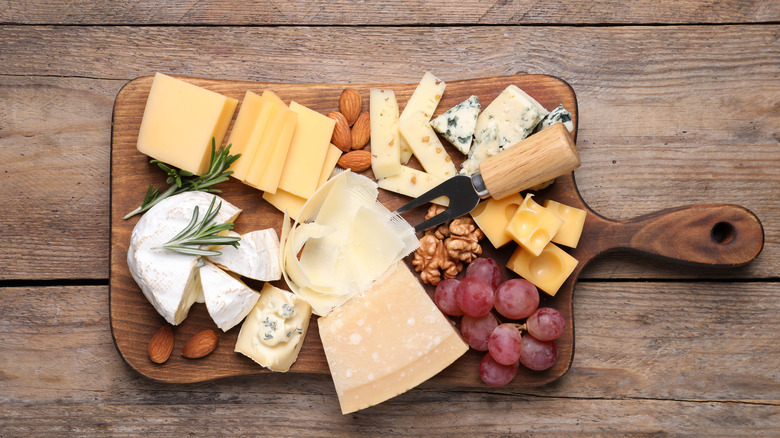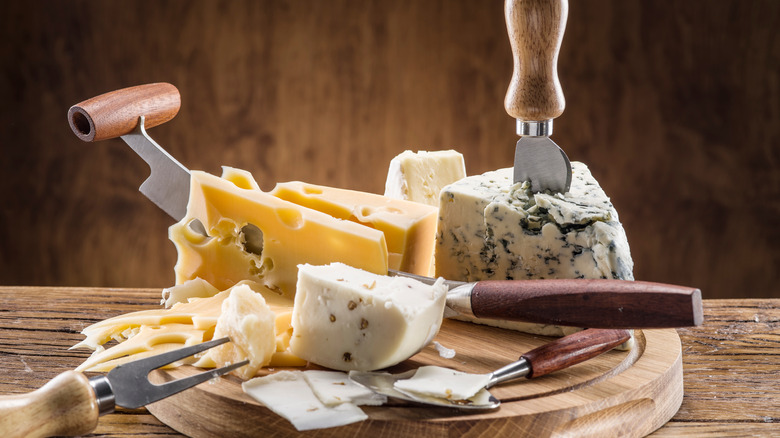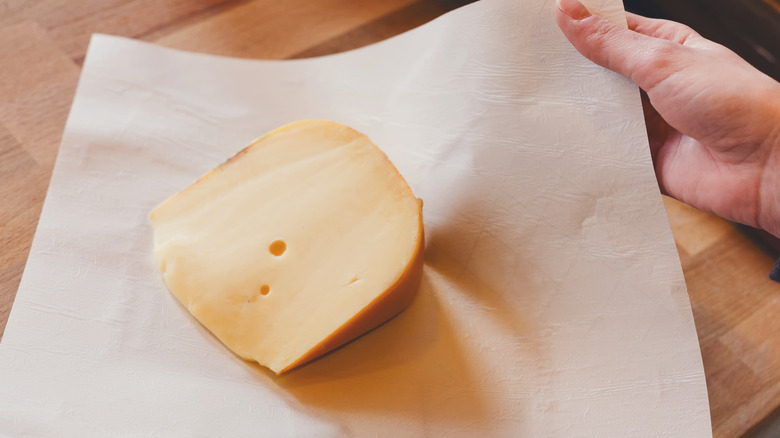Don't Make This Mistake When Building A Cheese Plate
We may receive a commission on purchases made from links.
From traditional snacks like deviled eggs to TikTok-inspired trends like butter boards, there's no shortage of ideas for snacks to set out at a party. However, there are few more classics (and perhaps popular) than the cherished cheese plate.
While building the perfect cheese board may seem like a cinch, there are, in fact, a few rules that experts recommend. For instance, Lauren Toth, training and curriculum manager at Murray's Cheeses, tells Food & Wine that she recommends choosing an odd number of cheeses and adding interesting accompaniments like varieties of pickles, nuts, or even shortbread in addition to standard crackers.
Food Network suggests choosing lighter-style cheeses for a pre-dinner plate while recommending creamy or intensely flavored styles for after-dinner grazing. And nearly any cheese aficionado will agree with the Food Network to allow the cheese to come to room temperature before serving.
So, if you're looking for ideas on how to build the best cheese board, you can certainly find yourself going down the Internet's veritable rabbit hole with recommendations on what you should do. But what is one of the top mistakes to avoid?
Don't cut too early
It's natural to want to prepare as much as possible ahead of party time so that you can enjoy the company of your guests as they arrive. However, cutting cheeses too far in advance can undermine the quality of the cheese plate you worked so hard to create.
Morgane Thomas of the now-closed French fromagerie L'Affineur'Affiné in Paris, which served as both a shop and a restaurant while it was open, offers practical reasons for resisting the urge to slice your cheese too early. "We strongly recommend cutting cheeses last minute," Thomas tells Food & Wine. "It's particularly true for the creamy cheeses because if you cut them in advance, they will fix together again."
As for hard cheeses, she advises against slicing those too soon, citing their tendency to dry out when exposed to the air for extended periods.
Cheese Grotto also recommends waiting to cut cheese until just before serving, highlighting the importance of leaving creamy cheese intact, explaining that breaking through the rind allows the oxidation process to begin. The longer the surface of the cheese is exposed to the air, the less moisture it will have, which necessarily alters the flavor.
Meanwhile, MasterClass offers a two-pronged approach suggesting slicing semi-hard and semi-soft cheeses while leaving soft cheeses such as brie and hard round cheeses whole. In this case, guests can cut them on their own using the appropriate cheese knives for each.
Storing cheese once it's sliced
Once the party is over, it's essential to consider the appropriate storage for any leftover cheese. While it may seem easy to grab some plastic wrap or foil, cheesemonger and owner of Brooklyn's Monger's Palate, Carol Johnson, advises against it. "Cheese is a living thing, so you have to wrap it in something breathable," Johnson told Food & Wine.
Corporate Chef Patrick Ochs says the same of plastic wrap, noting that it keeps moisture in and contributes to the degradation of the flavor (per Insider). He also advises explicitly against using aluminum foil. "Certain types of cheese contain levels of salt and acid, which can interact with the foil and infuse the cheese with a hint of aluminum flavor," Ochs said.
Johnson and Ochs both recommend cheese paper for storing cheese after slicing. Butcher paper, parchment paper, or wax paper are other options that one or both suggest.
So, for that next soirée, prep all those other appetizers and big-batch cocktails, but leave the cheese to the last minute. After all, no one wants to party with the person who commits crimes against camembert.


